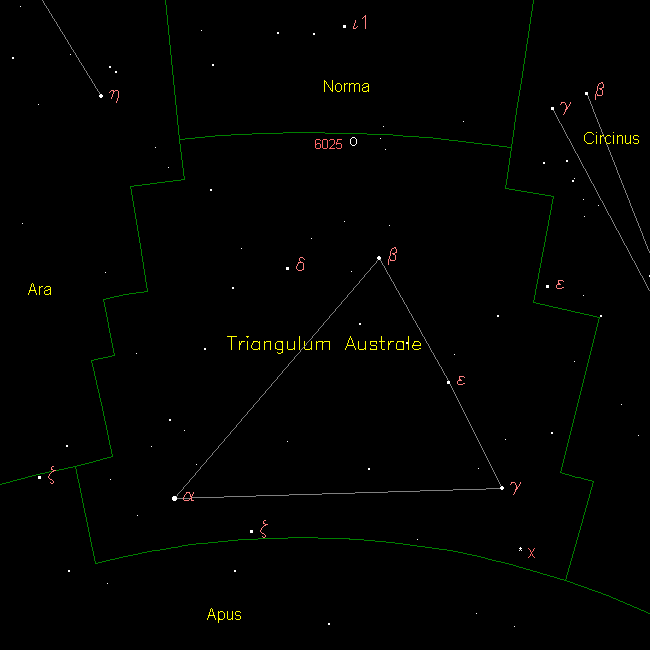[/caption]
The small southern constellation of Triangulum Australe was first introduced in 1589 by Petrus Plancius on a celestial globe which was later added to Johann Bayer’s atlas – Uranometria – in 1603. The constellation, then named “Triangul Australe” was later adopted by the IAU as a member of the 88 modern constellations. It spans 110 square degrees of sky, ranking 83rd in size. Triangulum Australe has 3 main stars in its asterism and 10 Bayer Flamsteed designated stars within its confines. It is bordered by the constellations of Norma, Ara, Circinus and Apus. Triangulum Australe is visible to all observers located at latitudes between +25° and ?90° and is best seen at culmination during the month of July.
Since Triangulum Australe is considered a “new” constellation, there is no mythology associated with it – only how its name came to be. During the late 1600s Dutch navigators Pieter Dirkszoon Keyser and Frederick de Houtman were exploring the southern hemisphere and part of their work dealt with charting the southern stars as well. Petrus Plancius, a celestial cartographer, had depicted a “triangle” of stars on his globe which appeared south of Argo Navis and with the Southern Cross. Their job was to confirm it! Later, Abbe Nicolas Louis de Lacaille would also journey to the southern hemisphere to chart the heavens as well, and on his maps he named this distinctive configuration “Triangle Austral ou le Niveau”. Because so many differing names and designations led to confusion, the International Astronomical Union eventually set the borders – and the name – at Triangulum Australe, the “Southern Triangle”.
Let’s begin our binocular tour with the brightest star – Alpha Trianguli Australis – the “a” symbol on our chart. Located approximately 415 light years from Earth and properly named Atria, here we have an orange K-type bright giant star which may harbor a spectroscopic companion. While it quietly fuses helium into carbon and oxygen in its deep core, Atria shines over 4900 times brighter than our own Sun! Classed as a barium star, this hybrid giant blows cool stellar winds hot surrounding magnetic corona. What makes Atria so curious is an abundance of x-ray emissions, which suggests the presence of a nearby white dwarf star!
Now, get out the big telescope for Beta – the “B” symbol on our chart. Alpha Trianguli Australis is located about 40 light years from our solar system and it is a true binary star. The primary component, Beta Trianguli Australis A, is a yellow-white F-type giant star, but you’ll need some aperture to see the 14th magnitude disparate companion separated from the primary by 155 arcseconds!
Ready for a change? Then let’s take a look with binoculars at X Trianguli Australis, a very fun variable star! Almost any optical aid will help you spot this clever little red carbon variable. It’s around 1500 light years away and at the dimmest it will appear to be about stellar magnitude 7. Keep an eye on it, though… Because it will brighten to magnitude 6!
For either binoculars or telescopes, let’s have a look at splendid open cluster, NGC 6025 (RA 16 : 03.7 Dec -60 : 30). On the edge of being detectable to the unaided eye, apparent magnitude 5, NGC 6025 spans about 12 arc minutes in size and was discovered by Nicolas Louis de Lacaille. For deep sky fans and those working on challenge objects, you’ll find it is included in Sir Patrick Moore’s Caldwell Catalogue as Caldwell 95 and on the Astronomical League’s Southern Sky Binocular List. Even small optics can easily resolve out about 30 or so stars from this rich galactic cluster! NGC 6025 has been highly studied to see if it contains binary stars, or rapidly rotating stars with spots that might pose as unseen companions.
Don’t forget the big scope for other challenge objects like planetary nebula NGC 5979 (RA 15 : 47.7 Dec -61 : 13). Nearly stellar in size, this small planetary will require the aid of a nebula filter to pick its small disc out from the surrounding field. There are also two very faint galaxies, NGC 6156 (RA 16 : 34.8 Dec -60 : 36) and NGC 5938 (RA 15 : 36.4 Dec -66 : 52), but both their size and magnitude will make them nearly impossible for all but the largest of telescopes.
Sources:
Wikipedia
University of Wisconsin
University of Illinois
Chart Courtesy of Your Sky.

